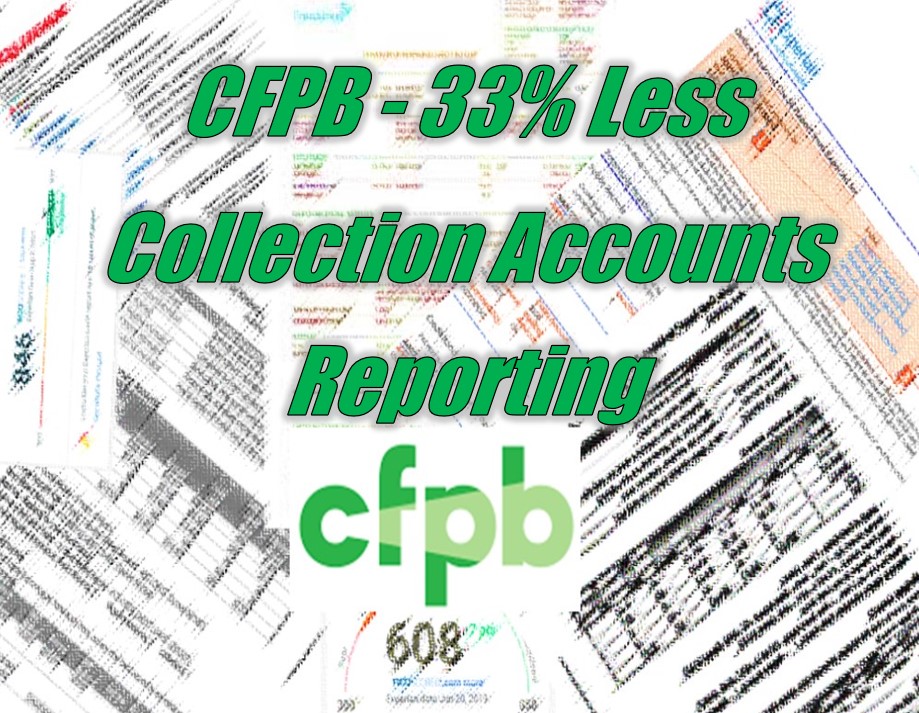“The report found the total number of collections tradelines on credit reports declined by 33%,”
The Consumer Financial Protection Bureau’s war on credit reporting rages on. Last year, by decree, they managed to wipe away most medical debt from credit reporting. With their latest report boasting a 33% reduction in collections accounts, it makes one wonder if we need to revisit our perceptions of what good credit really looks like if we don’t know what is now hidden from us?
People with (thin files) three or four low balance credit lines and three years of credit with 785 FICO scores have become more common than most would think. The results, fair or not, are changing the perceived value of FICO scores in underwriting.
That someone should suffer a six-year reporting of a $25 medical debt is obviously heinous, but when there is a long history of unpaid cell phone bills, utilities and other collections activity not disclosed to lenders, isn’t this obscuring reality and creating unknown financial risks?
Regardless of your thoughts on this, below is part of the CFPB’s memo and report on their examination.
Read the Report Here!
On Monday, the Consumer Financial Protection Bureau (CFPB) released a report examining trends in credit reporting of debt in collections from 2018 to 2022. The report found the total number of collections tradelines on credit reports declined by 33%, from 261 million tradelines in 2018 to 175 million tradelines in 2022. The share of consumers with a collection tradeline on their credit report decreased by 20% in the same timeframe.
Collections tradelines are furnished to credit reporting companies by third-party debt collectors. Commonly reported collection items include medical, rental and leasing, credit card, and utility accounts.
Unlike most other tradelines, debt collection tradelines rarely report positive information like on-time payments, and result in reporting of collections tradelines being almost entirely harmful to consumers. Collections tradelines are visible to potential lenders, employers, landlords, and others who run credit inquiries or background checks. Collections tradelines can limit people’s access to jobs and housing, as well as decrease credit scores and increase the cost of credit. Given the potential damaging impacts of collections tradelines, reporting of inaccurate data is especially harmful.
Market Snapshot: Trends in Third-Party Debt Collections Tradelines Reporting
FEB 14, 2023
This report provides an overview of the trends in third-party debt collections tradelines on consumer credit reports from 2018 to 2022. The report uses data from the Bureau’s Consumer Credit Panel (CCP), a nationally representative sample of de-identified credit records maintained by one of the three nationwide credit reporting companies. A collections tradeline is an item on a consumer’s credit report. It includes information about an individual’s allegedly unpaid bills. Credit scoring models use the information contained in tradelines, including collections tradelines, to generate a consumer’s credit score. Collections tradelines, which are considered negative, generally may appear on a consumer report for up to seven years. Among other things, the report finds:
From Q1 2018 to Q1 2022, the total number of collections tradelines on credit reports declined by 33 percent, from about 261 million tradelines in 2018 to about 175 million tradelines in 2022.
The decline in furnishing is driven by contingency-fee-based debt collectors, who furnished 38 percent fewer tradelines from Q1 2018 to Q1 2022.
The number of contingency-fee-based debt collectors furnishing tradelines declined by 18 percent (from 815 to 672) over the same period, while the number of debt buyers who furnish collections tradelines held constant from 2018 to 2022 at 33.
Contingency-fee-based debt collectors primarily furnish medical collections tradelines, while debt buyers primarily furnish financial collections tradelines.
Medical collections tradelines still constitute a majority (57 percent) of all collections on consumer credit reports.
CFPB Boasts of Reduced Collections Records in Credit Reports – Consumer Financial Protection Bureau – CFPB













Facebook Comments